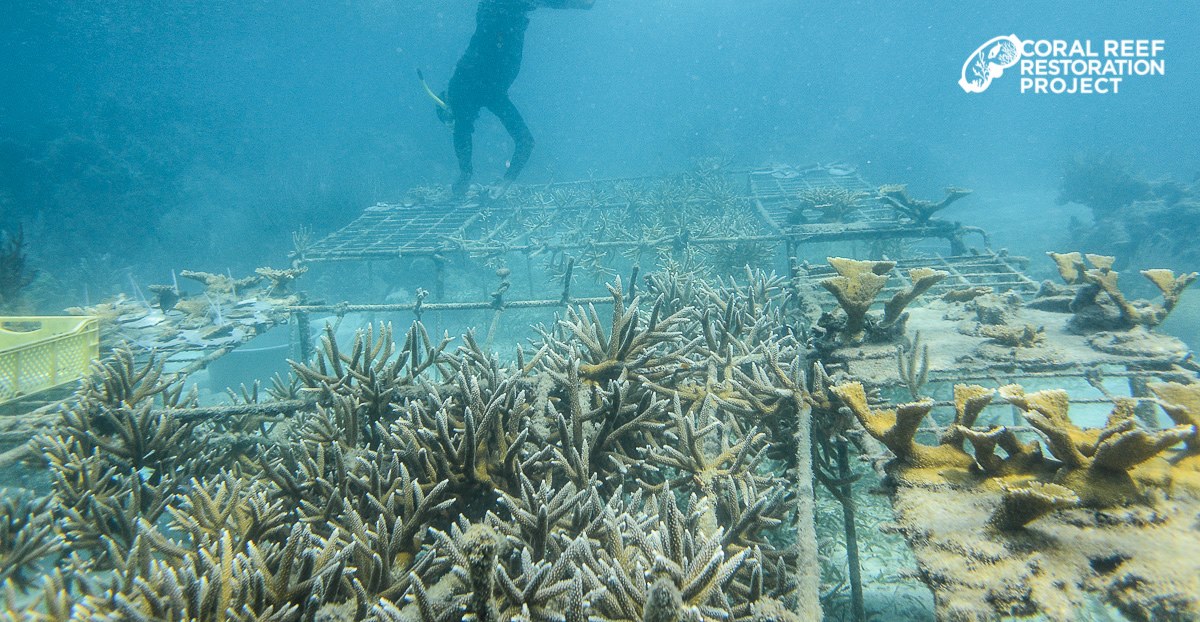Laughing Bird Caye National Park in Southern Belize is home to one of the Caribbean’s more successful reef restoration projects. With over 30,000 coral fragments planted to date, Fragments of Hope is a true ray of hope for the future of Caribbean reefs.
Marine Biologist Lisa Carne has been leading the restoration initiative in Belize for ten years, growing corals in rope nurseries and slowly restoring the reefs of Laughing Bird Caye National Park. The restoration project focus on the culture of Acropora palmata, A. cervicornis, and the hybrid coral, A. prolifera, although ten other coral species including, Dendrogyra cylindrus, Agaricia (Undaria) tenuifolia, Colpophyllia natans, Orbicella annularis, O. faveolata, O. franski, Diploria strigosa, Pseudodiploria clivosa, Porites furcata and Montastraea cavernosa are also growing in the nurseries.
The Fragments of Hope corals are grown on a cleverly designed rope nursery adopted from Austin Bowden-Kerby. Ph.D which helps save time when it comes to transplanting coral. Long strands of rope are strung between steel frames which are buried firmly in the seafloor. To attach the corals, the ropes are simply twisted apart and the fragment inserted between the strands.
One benefit of this technique is that once the corals are large enough, the entire coral encrusted rope, or smaller cut sections of the rope can be removed from the nursery and attached directly to the reef. The corals will grow in the nursery for about one year depending on the species and nursery location, after that they are transplanted to the reef.
Other corals growing in the rope nurseries are fragmented and individual branches of coral are attached to the reef using a cement mixture or cable ties. Fragment of Hope is also growing corals on small cement disk or frag plugs and these corals are transplanted to the reef once they have grown to a healthy size.
Since 2009 fragments of Hope has been successful in raising and transplanting corals in Belize and has documented over 6 years of survivorship on some of their transplanted corals in Laughing Bird Caye. In an effort to replenish corals reefs which are more resilient to climate change, the restoration project has focused on identifying and propagating corals which are most resistance to bleaching and disease. However this has not happened without some setbacks, as they have documented white band disease, rapid tissue loss, predation from snails, fireworms & fish as well as damage from boat anchors and invasive sponges.

A true testament to success of Fragments of Hope is the annual coral spawn which they have been able to document since 2012. In 2012 Fragments of Hope documented four different A. cervicornis genotypes with gamete formation, less than two years after they were out planted. Spawning staghorn corals where also observed in 2014 and by 2015 Fragments of Hope observed all 3 nursery-grown, outplanted acroporids spawning. All this spawning is good news as it further helps to re-seed the surrounding corals reefs.
Fragments of Hope does an excellent job of documenting their progress posting lots of great pictures and regular updates on their Facebook page. If you would like to support Fragments of Hope you can find membership information here.




